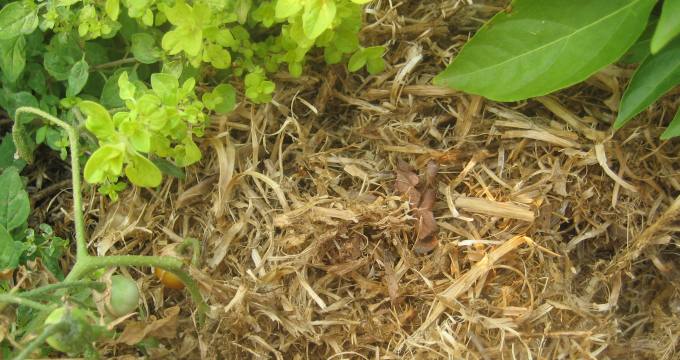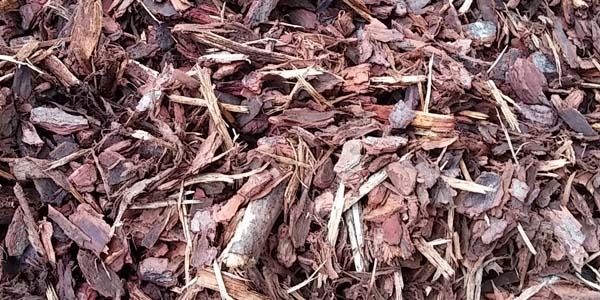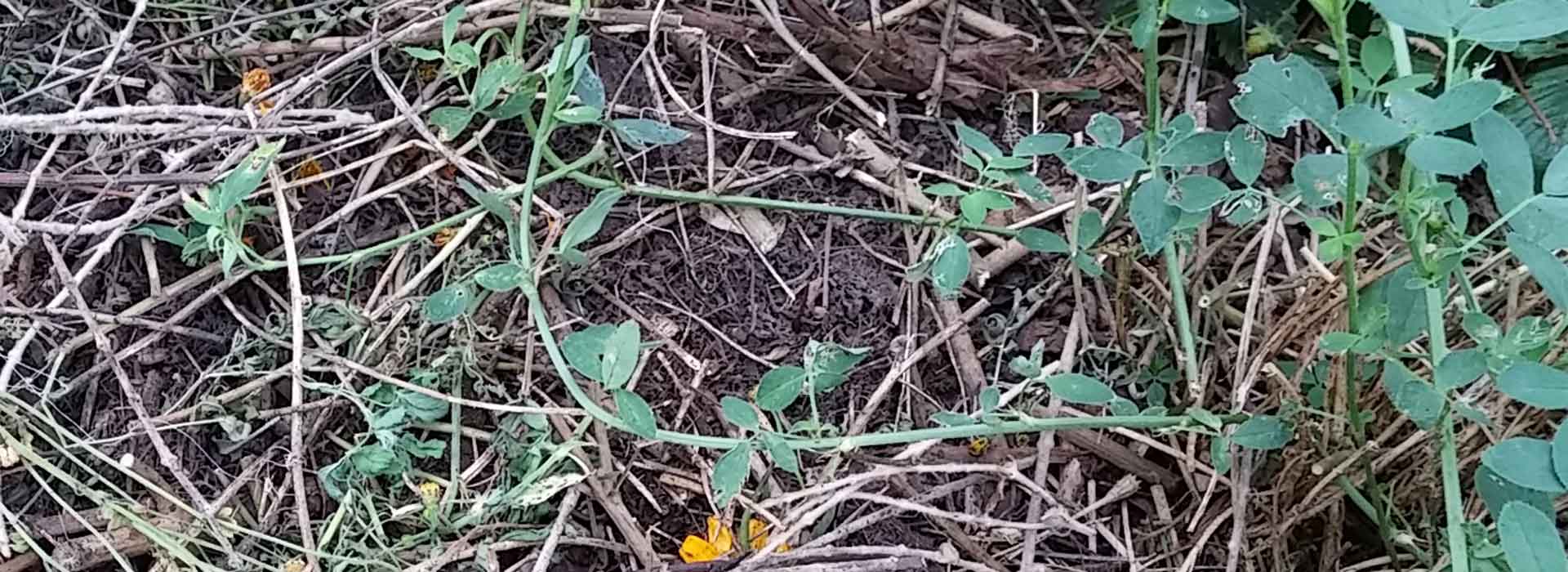Is Your Tea Sustainable?
Tea has been a favorite beverage of many cultures for centuries. Drunk originally in China for medicinal purposes it is now mainly drunk to get a 'lift'. But there are now dozens of different teas from many plant sources and all come in different types of packaging, loose, in cans or boxes or in little bags. We can also grow teas at home – even in Australia. These different methods of obtaining tea differ in their sustainability and maybe grow-your-own is best.
he early 1600s. Its use then spread to France, Germany and Great Britain in the mid-1600s. Initially only drunk by the wealthy because it was expensive, it became more widely used when more was imported and the price fell to the point where it could be regarded as a typically British beverage2.
Growing Tea
Most tea production has been in humid areas with rich, acid soil and high rainfall. It grows well in tropical and sub-tropical climates with partial shade, but in other areas it needs full sun as long as it receive sufficient water. Pesticides are used in many tea-growing areas3, but their levels are reduced in the final products if the tea leaves have been washed during processing.
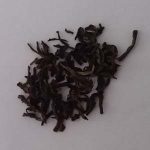 In Australia, tea is grown in many regions from north Queensland through to Victoria and Tasmania4,5. It has an advantage that it does not need pesticides because Australia’s quarantine regulations have prevented pest entry.
In Australia, tea is grown in many regions from north Queensland through to Victoria and Tasmania4,5. It has an advantage that it does not need pesticides because Australia’s quarantine regulations have prevented pest entry.
Nerada in far north Queensland is perhaps the oldest tea company - the Cutten family commenced growing tea in 18866.
Unfortunately, cyclones and a tidal wave nearly destroyed the plantation. However, in 1958 Dr. Maruff started a commercial tea enterprise using the seeds and cuttings from the surviving original plantings and created the basis for the largest tea company in Australia. Its products are free of pesticides7.
There are now a number of other tea producers including Madura, Alpine, Two Rivers, Jemidee, Daintree and more.
How about growing your own?
There are a number of suppliers of tea plants grown from cuttings in Australia - seed-derived plants may not have the same properties as the parent. Plants can be grown in pots or as hedges since they withstand both leaf harvest and more aggressive hedge trimming. Pots have the advantage of being movable if the weather becomes too hot and dry or too cold. Soil should be enriched with compost and organic fertilizer and kept moist. It is a good idea to grow two or more plants so that you can harvest leaves from one while the other(s) keeps growing. Harvest should be possible after 2 – 4 years. For more detail click here.
As well as providing a tasty drink with a mild caffeine-hit, tea leaves can be used as a flavor enhancer in other foods and as a breath freshener.
Making the best brew
How to make the best cuppa varies with not only the type of process to make commercial products but also with water temperature, length of brewing time and whether milk is added. For advice click here and here.
Herbal Tea
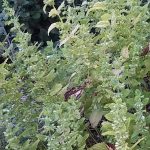 If you don’t like caffeine try herbal tea! And here is the real opportunity to grow your own if you want to have really fresh leaves, reduce your environmental impacts (no transport, pesticides or packaging) and cost and to provide bee forage! However, many are also commercially available.
If you don’t like caffeine try herbal tea! And here is the real opportunity to grow your own if you want to have really fresh leaves, reduce your environmental impacts (no transport, pesticides or packaging) and cost and to provide bee forage! However, many are also commercially available.
Most are easy to grow in pots or in the ground and the list is extremely long8. The most common ones are:
- Leaves: lemon balm, the mints, rosemary, raspberry, catnip, nettle, dandelion, lemon verbena, bee balm, thyme and coriander
- Flowers: elder, lavender, jasmine, chamomile.
- Roots: ginger
- Stalks: lemon grass
- Other: rose hips
- More for medicinal use: Horsetail, hyssop, motherwort, mugwort, Echinacea, yarrow, feverfew, calendula petals, fennel, sage.
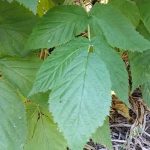 Use fresh or air dry. To maintain plants, use only a few leaves at a time. Because some of these grow very easily, they are regarded as weeds. So watch out for those with invasive roots e.g. nettle, mints, raspberry, which are best grown in pots. Also be careful with those that establish too easily from seed e.g. nettle and lemon balm, which should be pruned before the flowers set seed.
Use fresh or air dry. To maintain plants, use only a few leaves at a time. Because some of these grow very easily, they are regarded as weeds. So watch out for those with invasive roots e.g. nettle, mints, raspberry, which are best grown in pots. Also be careful with those that establish too easily from seed e.g. nettle and lemon balm, which should be pruned before the flowers set seed.
Native herbal teas
Even better, try tea from Australian native plants. Perhaps the easiest to grow are lemon myrtle Backhousia citriodora or aniseed myrtle Syzgium anisata. Although they are both rain forest trees they are very adaptable and don't grow more than about 3 m in suburban settings. In summer they are covered with flowers which are attractive to bees, butterflies and nectar eating insects. Their leaves make teas tasting of lemon and aniseed respectively.
A number are commercially available e.g. lemon myrtle, wattle seed and blends incorporating peppermint gum leaves, rosella, wild hibiscus, lilli pilli, pepperberry and strawberry gum.
Tea Bags - Pros and cons
Tea quality
Making tea in a pot is not everyone’s cup of tea, so to speak. Tea bags are very convenient, they are easily transportable, allow for easy choice of strength of brew for individuals and don’t require fiddling with a tea pot.
However, the content of bags is variable. The tea is the “dust” that accumulates at the bottom of containers where tea leaves are dried. Although this dust is still tea, the fine particle size allows rapid release of flavours including unwanted bitterness so that the result may be less pleasant than tea brewed correctly from whole leaves. The content of different types of bag (rectangular, round, pyramid, sachets) may be primarily dust, whole leaves or fragments, depending on what works best with the shape9 and this variability means that the quality of tea flavor also varies.
Bag Composition
Unfortunately, there are potential risks associated with the material used to make some bags. They are normally made from paper or other cellulose products, such as from corn starch, but are frequently stabilised with various types of plastic e.g. rayon, PVC or polypropylene so that the paper does not fall apart in hot water10. It is likely that some of this plastic leaches out into your tea. Moreover, epichlorohydrin, a potential carcinogen, is added to the paper to increase its wet strength11 and can also leach out. And even the paper may have been bleached with chlorine.
Is the Bag Compostable?
There is some debate about whether tea bags should be added to compost systems because many contain microplastics, toxins or bleach. All of these substances can be broken down by soil organisms, but it is not known to what extent they will decompose in compost. If they are not fully broken down they may leach out and find their way into ground water and eventually streams. In Europe, microplastics are found in tap water and sea salt but it is not clear if they pose a significant risk to human health12. The contribution that tea bags make to this is pretty small though, given the large scale use of plastics elsewhere.
If you want to avoid adding these unwanted chemicals and plastics to compost, you should break tea bags open and only compost their content, throwing the outer material in the rubbish.
Our Recommendations
For a cuppa of conventional tea which is exquisite-tasting, healthy and has lower environmental impact use:
- Loose leaf tea made in a tea-pot using optimum water temperature and brewing time that has been grown organically.
- Use Australian grown – there is low or no pesticide contamination and environmental impacts of long distance transport are reduced.
- Grow some of your own if the climate is appropriate.
- If you must use tea bags, look for those that contain whole leaves and are made from wholly natural materials.
- If you want to avoid caffeine go for herbal teas – either loose leaf or in bags chosen according to the criteria mentioned above.
To minimize environmental impacts buy Australian!
And even better, grow your own!
References
- http://www.homelife.com.au/gardening/how-to-grow/growing-tea
- https://en.wikipedia.org/wiki/History_of_tea
- http://healthyhayles.com/home/what-is-actually-in-your-tea
- www.abc.net.au/news/2016-03-03/tasmanian-tea-farm-viable-rival-wine-industry/7216322
- https://en.wikipedia.org/wiki/Tea_in_Australia
- www.neradatea.com.au/our-story/philosophy
- https://www.growveg.com.au/guides/grow-your-own-fresh-herbal-teas/
- https://ratetea.com/topic/loose-tea-bags-sachets-compressed-blooming/18/
- http://moralfibres.co.uk/is-there-plastic-in-your-tea/
- https://www.openpr.com/news/888703/Epichlorohydrin-Market-Size-Growth-Latest-Trend-Forecast-2023.html
- https://www.foodnavigator.com/Article/2017/09/13/Microplastics-found-in-food-and-water-Food-scare-or-perfectly-safe
Sustainable Garden Edging

Why bother with garden edging? Why not just let plants grow up to the edges of lawn (if you have it) or of paths? Unfortunately, soil and mulch migrate from garden beds because of rain or birds which love to scratch in it. And some plants send their roots further than the bed and, conversely, some lawn grasses will enter your garden beds. Some sort of edging is necessary if you want raised beds.
There are many forms of edging commercially available, but they differ significantly in their sustainability. However, natural or recycled materials make excellent edging and can add uniqueness to your garden as well as minimising manufacturing impacts and waste going to landfill. Read more
Choosing Mulch for Your Garden
There are different reasons for using mulch in your garden, so it’s important to choose the best mulch for your purposes. And there are so many different mulches available with different appearances, prices and characteristics.Read more
Could manures, composts or mulch damage plants?
As sustainable gardeners we are probably relying quite a bit on commercially sourced compost, manures and mulch to help promote healthy plant growth. But do these products reliably do that? Over the last decade or so there have been problems worldwide with contamination with substances that harm seeds and plants that we want to grow and eat.
The problem

Shows leaf crinkling, leaf curling, leaf distortion, leaf malformation, stunting
In the 2000s, a few reports by market and home gardeners of mysterious plant damage emerged in the UK and USA. These included poor seed germination or deformed, wilting or twisting leaves. Plants affected included roses, grapes,sunflowers, potatoes, lettuces, tomatoes, spinach, some fruit, squash, hops and legumes (beans, peas, clover, lupins, acacia). In 2009, whole crops were lost in the US and hundreds of thousands of dollars’ worth of damage was done to community gardens and organic farms.1 The damage was traced to carryover of toxic substances from straw/hay mulches, composts and manures. And, of course, if from spray drift to fields or gardens. The culprits were one or more of a group of compounds that mimic naturally occurring plant hormones, called auxins, which regulate plant growth. They were pyridine carboxylic acids (pyridines) – aminopyralid2, clopyralid3, picloram, fluroxypyr or triclopyr, the active ingredients in broadleaf herbicides which affect the division of cells causing them to became disorganized and uncontrolled, eventually destroying plant tissue.
These substances are available in agricultural products, either alone or in combination, as selective herbicides to kill broadleaf and woody weeds such as docks, thistles and nettles, blackberries, gorse, hawthorn, lantana, dock, ragwort but allow other plants to grow. They have mostly been used in pastures, but also in crops of corn, wheat, barley, oats, wheat, triticale, canola, fallow land, in forests on golf courses, parks and on grass along highways. Since pyridines are growth inhibitors, they are only effective if sprayed on actively growing plants. Problems observed in plants grown by market and home gardeners were a result of carryover of these substances from composts, manure and mulch derived from sprayed land.
In Australia a number of years back, there have been reports of problems in home gardens. Agricultural products currently containing these pyridines include Tordon, Grazon, Stinger, Tri-Pick, ForageMax, Hotshot, Starane, Spearhead and Vigilant4.
How do these substances get into edible plants?
Under the right conditions pyridines persist in sprayed pasture and crops and in soil for a long time. The half life (i.e. time taken for half the amount to be broken down) of aminopyralid 32 - 533 days, very commonly around 103 days and it is stable in water (see Chemwatch aminopyralid.pdf). Breakdown is largely by microbial action. Clopyralid’s half life in soil is 1 – 2 months but can extend to 1 year depending on conditions3. Picloram has a half life of about 2 months in heavy clay soil but if organic material is present in the soil, its half life can be much longer. Again, breakdown is by soil microorganisms and occurs slowly. These substances are quickly taken up by plants via their roots, a little via their leaves and they easily translocate through the rest of the plant. The other two compounds, trichlopyr and fluoroxypyr have half lives of around 40 days in soil and around 1 day in water.
These substances are resistant to digestion by animals grazing on sprayed pastures so can be found in manures – and in concentrations high enough to damage plants that are sensitive to them. They are also resistant to the high temperatures of commercial composting. And susceptible plants need only minute concentrations to be affected.
Once the problem was recognized, Dow AgroSciences, the main manufacturer, suspended production of the offending products for a while. Now, however, the substances are still in use but with labelling and warnings in information accompanying the products.
Warnings to Prevent Problems
Statements, which vary with the product, include “do not plant crops for up to 9 months after spraying”, “Do not send treated crops off-farm as fodder or forage.” For example, the statement on ForageMax (aminopyralid) is:
“MANAGEMENT OF RESIDUES IN COMPOST MULCHES AND ANIMAL WASTE
Do not send treated crops of farm as fodder or forage. Aminopyralid residues from treated plants may pass into animal manure. If the manure is used to make compost or spread around plants it may cause injury to sensitive plants. Do not spread manure from animals that have grazed or consumed forage or fodder from treated areas on land used for growing susceptible broadleaf crops.
Dairy and feed pad effluent
Effluent from animals grazing forage brassicas treated with ForageMax within the last 4 weeks may contain residues. Effluent from these animals may contain residues for 3 days after removal of the animals from the ForageMax treated crops. Disposal of this effluent by irrigation may cause damage to clover and other sensitive crops during this 3 day period. Do not send any effluent (or compost made from it) off-farm, from animals that have grazed on crops treated with ForageMax within the last 4 weeks, until the animals have grazed for 4 days on clean feed. This restriction is not required if 4 weeks has elapsed from treatment to grazing or the animals have been on clean feed for at least 3 days.5
Can warnings on product labels and instructions for use prevent problems?
Ideally “yes” - if users read and obey them. However, some products have brief and confusing statements – one saying that there is no withholding period for grazing, another (Tri-Pick) “check the label for the withholding period for these crops” and another states “at least 7 days”.
As the United States Composting Council wrote in 2013 (current publication date is May 2016)1 "Instructions on labels often appear complicated, they may not be read completely, or if they are, are not fully understood or not followed accurately. Though some applicators might follow instructions correctly, there are usually others downstream who receive treated residues and may be unaware of the initial labeling requirements. Others may be aware of labeling requirements but choose to ignore them"
As a result, they call for more action: "The US EPA (Environment Protection Authority) should revoke the registration of all herbicides known to persist in compost at levels that are toxic to plants and require that these products be removed from the market." Currently, the US EPA indicates that a review started in 20146 but, as far as we are able to determine, no result has yet been forthcoming.
Pyridines in Herbicides for Garden Use
Unfortunately, pyridine compounds are also present in some garden products, so if you are using them (most sustainable gardeners don’t) watch out!
They are mostly called “blackberry and tree killer” or “blackberry killer”. Picloram and triclopyr (the less problematic chemical) are in Superway Tri-Pick. A number of other products contain triclopyr. Warnings about their use vary and include “The estimated half-life in above ground drying foliage as in a forest overstory is 2 to 3 months”, “Insufficient data to be sure of”, “Do not allow spray to get on to plants wanted”. One Tree Blackberry Killer warns not to let spray touch non-target plants.
Should we be cautious?
The warnings on agricultural products are certainly reducing the frequency of pyridine carryover in compost, mulch and manures and, therefore, subsequent plant damage. However, these compounds are not routinely tested for in such products and we don't have information on whether they are still likely to be present. But it would be wise when buying these products, to do one or more of the following:
- For mulches and composts, ask your supplier about the source, what sprays had been used, withholding periods etc
- For manures ask what food the animals had eaten. If grazed on pasture, ask about sprays and withholding periods. Bear in mind the a lot of cow manure comes from feed lots and it is not easy to know what the cattle had been fed.
- Use only lucerne or pea straw as mulch since the growers of such legume crops would not use pyridine herbicides because they would kill their crop
- Buy only organic-certified products
- Make your own compost and mulch
- Get your own chickens to provide manure, but check what you feed them
- Avoid blackberry and tree killers containing pyridines.
References
1. http://compostingcouncil.org/wp/wp-content/uploads/2016/05/USCC-Position-Statement-on-Persistent-Herbicides-FINAL.pdf.
2. www.beyondpesticides.org/assets/media/documents/infoservices/pesticidesandyou/documents/aminopyralid.pdf.
3. www.invasive.org/gist/products/handbook/11.Clopyralid.pdf.
4. www.croplife.org.au/resistance-strategy/herbicide-mode-of-action-groups.
5. http://msdssearch.dow.com/PublishedLiteratureDAS/dh_0940/0901b80380940cc9.pdf?filepath=au/pdfs/noreg/012-10959.pdf&fromPage=GetDoc.
6. www.epa.gov/pesticide-reevaluation/groups-pesticides-registration-review.
Sustainability of Horizontal Garden Surfaces
In order to walk around your garden, or to have open spaces for table and chairs, you might be seeking to install a surface that is firm, attractive and needs little care. Or you may want something with similar characteristics to use as a mulch alternative. There are many suitable materials available from garden centres. But how do the different products stack up with respect to their sustainability? There are many factors to consider in addition to their appearance.
As sustainable gardeners we may wish to use natural materials. However, natural ecosystems may be devastated simply to create paths or provide mulch for garden beds. Additionally, there are a range of environmental costs in their production and bringing them to your front or back door.
Production impacts
It is difficult to determine which product has the least impacts because there are so many factors to consider. Since most products, or the materials that go into them, come from the ground, they must be mined from a quarry of some type. So, first, let’s look at the impacts of quarrying.
Quarrying
Land disturbance and biodiversity loss
A quarry is a hole in the ground so quarrying will destroy vegetation and habitat of the land which is occupied by the hole as well as by any surrounding processing and transport infrastructure. Depending on the location this may, particularly in some developing countries, also destroy farming land, cause collapse of river banks and even deforestation.
Air and water pollution
Fine particles are generated by digging, blasting, crushing and grading operations, trucking and storage piles. Wind will carry such dusts considerable distances posing health impacts on nearby settlements. Rain may wash dust and other waste materials into streams where the resulting increase in concentration of suspended particles inhibits aquatic life because of reduced penetration of sunlight. Particulates may also affect the quality of water supplies.
Noise
Blasting, digging and transportation of quarried material are noisy operations affecting those nearby or on transport routes.
Energy use
Quarrying is not one of the most energy-intensive industries, being outranked by manufacturing and electricity production. However, transport of materials to the end-user uses lots of fossil fuel.
Products
All the products below are durable and will not need to be replaced frequently. They will have the impacts described above – and for some, many more.
Gravel, Pebbles and Crushed Rock
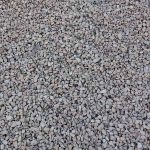 These come from rocks that are not connected to each other and are generally found where movement of water in lakes, oceans or rivers prevent them fusing. They are commonly used for driveways or paths but may be used as inorganic mulch because of their good water penetration, drainage, weed suppression and erosion control properties.
These come from rocks that are not connected to each other and are generally found where movement of water in lakes, oceans or rivers prevent them fusing. They are commonly used for driveways or paths but may be used as inorganic mulch because of their good water penetration, drainage, weed suppression and erosion control properties.
Crushed stone
Lilydale, Dromana or Tuscan toppings are mixtures of fine aggregates 10 - 40 mm in size. Lilydale toppings come from limestone so when wet they have a tendency to bond together and make a firm surface. Tuscan toppings come from sandstone and have a pink/terracotta colour. Because crushed stone products are in plentiful supply it is cheap with the main cost of selling being transport. Therefore, they are usually taken from land close to urban areas.
Gravel is generally larger and mostly used in roadways, but sometimes in gardens.
Pebbles
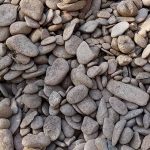 They come from 4 main sources:
They come from 4 main sources:
1. Active streambeds and beaches: Removing rocks, pebbles and sand from waterways is outlawed in Australia under state legislation. This is not necessarily so in the rest of the world. Some landscaping pebbles sourced from overseas have been mined from active streams and beaches, damaging these landscapes. These pebbles are supplied in their natural state after washing but are not polished.
2. Mining by-products: manufactured from the remains of natural stone quarrying overseas. These are usually tumbled to take off the sharp edges, but are not polished.
3. Sand mining refuse: These are picked out of a stockpile of stone that is sieved after sand mining operations. The stones are tumbled for about 6 hours and wax dipped prior to bagging
4. Land quarries of old stream routes: Over time there is a change in the routes that streams take as they flow to the sea. This leaves behind deposits of sand, rocks and pebbles that can be quarried from dry land without damaging existing streams.
Usually, if pebbles are available in bulk, they will have been quarried in Australia without damaging an active stream and some companies stock local and imported pebbles that are mined in low impact ways.
Concrete
The invention of concrete by the ancient Romans revolutionized surface paving. It may be poured or formed into pavers. Concrete consists of cement, some sort of rock e.g. sand or gravel and water.
Cement is made from limestone mixed with other materials such as clay and heating it to very high temperatures. This process causes limestone to react with the other materials releasing carbon dioxide. So concrete has impacts derived from quarrying limestone and other added material plus a whole lot more. Cement contributes around 5% of human-derived carbon dioxide emissions with most coming from the chemical process but significant amounts from the fuel used to heat kilns. Additionally, gases such as sulphur dioxide, carbon monoxide and hydrocarbons released during the chemical reaction cause air pollution. There are large amounts of water used in the process producing alkaline waste water which must be disposed of safely.
So concrete has impacts of both quarrying and gravel mining as well as those of producing cement.
Bricks
 These make attractive paths and terraces and are easy to install. They may be laid on a simple sand base or set in mortar (Portland cement) when their impact will include that of cement. Bricks are made by heating clay, often mixed with other materials, to 1000o C so that, alone, their impact is mainly from firing them in kilns in the production process. Extruded bricks (those with holes) have less impact than solid dry pressed or moulded bricks because they use less clay.
These make attractive paths and terraces and are easy to install. They may be laid on a simple sand base or set in mortar (Portland cement) when their impact will include that of cement. Bricks are made by heating clay, often mixed with other materials, to 1000o C so that, alone, their impact is mainly from firing them in kilns in the production process. Extruded bricks (those with holes) have less impact than solid dry pressed or moulded bricks because they use less clay.
There are now so-called “Carbon neutral bricks” which are fired in kilns using an alternative fuel to coal or gas. Such fuels may be waste sawdust from nearby timber mills or fly ash (fine particles which are expelled as waste from the boiler). Across the brick making industry there are also efforts to reduce carbon emissions in transport, clay extraction, waste and packaging.
Pavers
There is a large range of pavers made from a variety of rocks including limestone, slate, granite, Travertine, bluestone and sandstone. There are also products such as ceramic and porcelain tile made from firing clay. Porcelain is harder and requires firing at higher temperatures. All have the impacts of quarrying. If set on a concrete slab a tiled/paved surface has the additional impacts of concrete.
Transport Impacts
Many types of stone and tile are imported from overseas which means they require considerable inputs of fossil fuel to bring them to your door. Even if they are quarried or manufactured in Australia, there can be long distance transport involved. So choose locally sourced products where possible.
Onsite Considerations
Durability
Once installed, the main impacts of different types of paving relate to their permeability and durability and, of course, to aesthetics and safety. Highly durable products such as bricks and concrete do not need to be replaced as frequently as gravel, crushed rock and pebbles which tend to migrate through foot or vehicle traffic into the surrounding garden beds.
Permeability
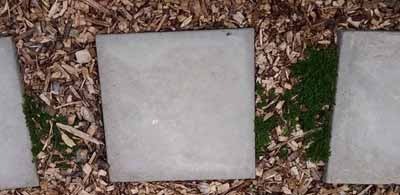 This important in managing and maximizing use of heavy rainfall. Any paving material set on concrete will cause water run off at the edges, perhaps causing erosion and loss of water from the site. Surfaces bedded on sand or where gaps between pavers are filled with gravel or ground cover plants allow rainfall to enter the soil and surrounds more gently and avoid offsite losses.
This important in managing and maximizing use of heavy rainfall. Any paving material set on concrete will cause water run off at the edges, perhaps causing erosion and loss of water from the site. Surfaces bedded on sand or where gaps between pavers are filled with gravel or ground cover plants allow rainfall to enter the soil and surrounds more gently and avoid offsite losses.
There are products which consist of pebbles or coarse toppings which are bonded to a firm surface with special glue which still leaves tiny spaces for water penetration. These will have the added small impacts of glue production.
Maintenance
Gravel, stones and pavers set with gaps between or without cement will allow seeds, often weed seeds, to germinate between them. If you don't like weeding, that may lead you to rip it all up and put in something that has no gaps - and you will have almost doubled the environmental impacts!
Deciding what to use
It is not easy to decide what surface is most sustainable. Negative impacts of production or transport may be counterbalanced by the product’s longevity, ease of maintenance, permeability and capacity to be recycled.
Using Recycled and Waste Materials
Possibly the most sustainable option is to choose from the large range of recycled materials which can make sturdy and attractive paths. These avoid impacts of production and, because they are usually locally sourced, those of transport too. Recycled bricks are possibly the most common but other possibilities are:
Concrete
You might smash up your own old concrete path into interesting shapes and lay it elsewhere as crazy paving. Commercially recyclers crush concrete which can be used as a base for paths or incorporated into slabs using added cement. Even the latter use has less impact that preparing fresh concrete.
Wood chips
While you probably wouldn’t choose these for a driveway, wood chips obtained from local tree-pruning operations can make useful surfaces between garden beds. They are permeable and soft to kneel on as you plant your veggies.
And More . . . .
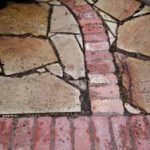

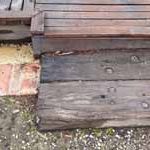 We have seen surfaces which incorporate recycled glass pebbles, the bottoms of glass bottles, old ornamental metal gratings, tiles, all sorts of recycled pavers and recycled hardwood. The range is enormous – your imagination and trips to recyclers will create your next pathway or non-degradable mulch!
We have seen surfaces which incorporate recycled glass pebbles, the bottoms of glass bottles, old ornamental metal gratings, tiles, all sorts of recycled pavers and recycled hardwood. The range is enormous – your imagination and trips to recyclers will create your next pathway or non-degradable mulch!
References
Willis. A-M. 1998. Concrete and not so concrete impacts Information Ecology, EcoDesign Foundation. http://www.changedesign.org/Resources/EDFPublications/Articles/Papers/Concrete.pdf
Banez J, Ajon S M, Bilolo J R, Marollano J, Nivero D. 2010. Quarrying and its Environmental Effects. https://www.scribd.com/doc/37181927/Quarrying-and-Its-Environmental-Effects
Skinder B M, Sheikh A O, Pandit A K, Bashir, Ganai B A. 2014. Brick kiln emissions and its environmental impact: A Review Journal of Natural Ecology and the Environment 6(1) 1 – 11. (www.academia.edu/6426675/Brick_kiln_emissions_and_its_environmental_impact_A_Review)
Your Health and Red-Purple Veggies
You may have heard how eating red/purple/blue fruit can improve your health. Most focus has been on cherries, black grapes (and, therefore, red wine) and a range of berries. Health benefits have been ascribed to the antioxidant properties of the anthocyanin pigments that they contain. But let’s not forget that there are also many other fruit and veggies that contain anthocyanins and other health-promoting pigments such as betacyanins and carotenes and that many are easy to grow.
Anthocyanins
The list of fruit containing these compounds is long. It includes cranberries, bilberries, red and black raspberries, blackberries, black and red currants, mulberries, elderberries, most of the cane berries like loganberries and jostaberries, blood oranges and purple olives. While the common tomato does not produce anthocyanins, purple tomatoes do. The red/purple colour in onions, purple corn, purple potatoes and carrots and eggplant skins is also due to anthocyanin.
The antioxidant properties of anthocyanins mean that they can scavenge forms of oxygen and nitrogen called free radicals which can damage lipids, proteins and DNA and, thereby, are helpful in several disease states. There has been much debate about whether these health benefits are due to their anthocyanin content or to other components of a diet which includes them i.e. one rich in fruit and vegetables. There are also questions about whether effects observed in animal studies or in human or animal cell lines in test tubes apply to anthocyanins in the diet. However, in studies where humans are given concentrates of anthocyanins from fruit or eat a lot of the foods containing them, there is evidence of reduced inflammation and protection from cardiovascular disease. In other diseases such as diabetes, obesity, cancer and declining vision with ageing, evidence from test tube experiments or from animal studies is conflicting and there is no clear support of benefits to humans.
Leafy “greens” containing anthocyanins
Quite a few leafy vegetables also contain anthocyanins. Most of us are familiar with red lettuce, both curly-leaved and cos forms, and with red cabbage. However, there are other less common examples which are all easy to grow.
Red bok-choy (Pak choi)
A member of the Brassica rapa Chinensis group (pictured in the banner image), it is a hybrid of the more common bok-choy, with red-purple infused through the leaves. Grow it as you would bok-choy i.e. it prefers the cooler months, so plant in early spring or late summer/early autumn in a moist, sunny position. Use leaves and stalks in stir-fries, or baby leaves in salads. The flavor is a little spicier than the green version.
Red Russian Kale
Among the many varieties of kale, the red stems and veins of this type (Brassica napus subsp. pabularia) contain anthocyanin. Fairly resistant to disease and able to adapt to different growing conditions, it is best planted in autumn and grown as a winter vegetable in a sunny spot, but can be grown in summer if given some shade. Like other Brassicas it prefers moist well-drained soil.
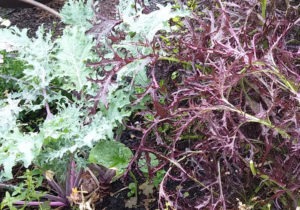
Harvest the outside leaves and the new leaves in the centre will grow and the plant remains productive for many months. Flavour varies with soil and temperatures, but can be eaten at any time. The stems can be tough so use the leaves. They are best sautéed in olive oil or steamed.
Red/Purple Mizuna
The fine-leaved red mizuna Brassica rapa nipponosica is a pretty vegetable. Like other Brassicas, it is best grown in the cooler months. It refers partial shade and keeps on producing if you harvest the outer leaves. Its tender, mildly spicy leaves and stems are best in salads, but can be added to stir-fries.
Rhubarb
Although technically not a leafy green since we don’t eat the leaves because they are poisonous, the rich red stalks of Rheum rhabarbarum stalks are edible. Rhubarb has the advantage of being a perennial vegetable. Plant crowns in spring, keep moist - but it will survive short dry periods, avoid harvesting until the second year of growth and remove any flower stalks. It can be divided in late autumn or winter to create new plants.
Harvest stalks that are about finger thick – greater thickness results in stringiness. Cooking is essential. Boil or steam with something sweet such as apples or pears. It’s very good added to apple crumble as it adds zing and richness.
Mustard Greens
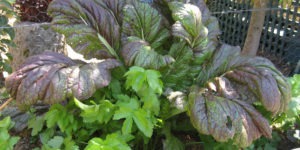 These stunning plants, Brassica juncea var. rugosa, are related to turnips, broccoli and cabbage. A cool season crop, best planted in late summer or autumn to early spring, it is very hardy, not requiring much special care. Leaves are mottled purple on top and green underneath. When young, they are tangy and spicy – with greater maturity they become quite hot and a little bitter. Use in salads with a flavoursome dressing or in stir-fries.
These stunning plants, Brassica juncea var. rugosa, are related to turnips, broccoli and cabbage. A cool season crop, best planted in late summer or autumn to early spring, it is very hardy, not requiring much special care. Leaves are mottled purple on top and green underneath. When young, they are tangy and spicy – with greater maturity they become quite hot and a little bitter. Use in salads with a flavoursome dressing or in stir-fries.
Betacyanins
Anthocyanins are not the only cause of red colour in fruit and vegetables. Betacyanins, members of the betalain family, are distinct from anthocyanins and the two pigments are not found in the same plants together. Betacyanins also have anti-oxidant and anti-inflammatory properties which contribute to health.
Swiss Chard
This leafy vegetable is a member of the same family a spinach and silver beet. Growing and harvesting details are here.
Amaranth
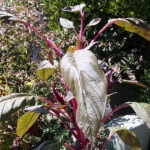 The large number of Amaranthus species consists of very striking, attractive plants producing many flower stalks which, if left to mature, provide a gluten-free grain, rich in iron, manganese, magnesium and selenium. It provided a staple crop for Aztecs and is now most frequently grown for its seeds in South America, Mexico, Nepal, India and China. Reaching nearly
The large number of Amaranthus species consists of very striking, attractive plants producing many flower stalks which, if left to mature, provide a gluten-free grain, rich in iron, manganese, magnesium and selenium. It provided a staple crop for Aztecs and is now most frequently grown for its seeds in South America, Mexico, Nepal, India and China. Reaching nearly 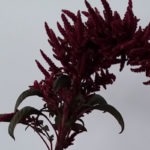 more than 1 ½ metres in height, it is very easy to grow, so much so that it may be regarded as a weed because of its prolific seed production. There are many species, 4 or 5 of which are grown for their leaves. New growth, stems and flower heads are a deep red. Leaves tend to be greenish on top but red underneath. Resistant to heat and drought, sow in mid-spring.
more than 1 ½ metres in height, it is very easy to grow, so much so that it may be regarded as a weed because of its prolific seed production. There are many species, 4 or 5 of which are grown for their leaves. New growth, stems and flower heads are a deep red. Leaves tend to be greenish on top but red underneath. Resistant to heat and drought, sow in mid-spring.
Use the leaves in stir-fries or cook as you would spinach – younger leaves and stalks are more tender.
Magenta spreen
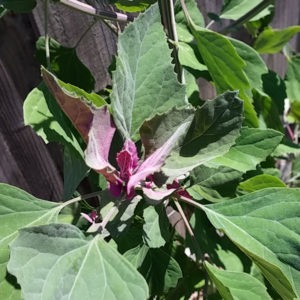 Also known as Giant Lambsquarters or Purple Goosefoot, Chenopodium giganteum is a rather uncommon vegetable. Like amaranth is makes a stately addition to your garden, often reaching 2 metres in height. Young growth is red with a pinkish “dust” on its surface. More mature leaves are red underneath and green on top. It is easy to grow. Sow in spring in either full sun or partial shade. It should be cut down before flowering to avoid unwanted seed spread. It has a high protein content and is rich in vitamins C and E, calcium and iron.
Also known as Giant Lambsquarters or Purple Goosefoot, Chenopodium giganteum is a rather uncommon vegetable. Like amaranth is makes a stately addition to your garden, often reaching 2 metres in height. Young growth is red with a pinkish “dust” on its surface. More mature leaves are red underneath and green on top. It is easy to grow. Sow in spring in either full sun or partial shade. It should be cut down before flowering to avoid unwanted seed spread. It has a high protein content and is rich in vitamins C and E, calcium and iron.
Like rhubarb, it contains oxalic acid, so preferably it should only be eaten when cooked using a steel, not aluminium pan. Its flavor is similar to spinach. However, some people blend the raw leaves to make smoothies. If you do this, it is wise to make this an infrequent event.
Carotenoids
These compounds give red and orange colour to some fruits and vegetables and, notably, carotene is the orange pigment of carrots from which its name derives. Carotenoids are found in a wide variety of vegetables, not just those that are orange or red like mangoes, melons, pumpkins, apricots, peaches etc. One of the carotenoids, lycopene, is present in significant concentrations in tomatoes, watermelon, pink grapefruit and guava. Many other vegetables which are green rather than orange, such as lettuce and spinach, are also rich in this compound.
Β-carotene is the precursor of Vitamin A, and, like lycopene it is important in the health ofr the immune system, eyes, skin, mucous membranes and certain forms of cancer.
The health message?
Given the range of natural pigments in so many fruit and veggies and the many different health benefits reported, it is most likely that eating a large variety of these foods is the way to go. Since many of them are easy to grow, why not get started now?
To Chop’n’Drop or Not
If you haven’t heard about “chop’n’drop” you can probably work out roughly what it means i.e. when pruning shrubs, trees or pretty much any plant, just leave the prunings on the ground. Much of the modern writing about this has arisen from within permaculture and has been strongly supportive of this approach. Let’s examine the pros and cons to work out whether it is right for your garden.
Actually chop’n’drop is a very old practice, variously called “cut and drop” or “slash and mulch”, carried out in most ancient farming cultures and still today in traditional cultures in central America. After rain, seeds for the next crop are sown under other plants, such as sunflowers, which are then chopped and left on the ground1. The chopped plant, such as the lucerne in the image above, act as mulch and the seeds for the next crop germinate underneath it. This is what you also see in natural ecosystems where leaf fall produces mulch and adds nutrients for seeds which have already fallen to germinate and grow.
Modern agriculture heralded use of mechanical methods (which may have initially just been wooden ploughs) to till the soil and introduced the use of expensive chemical herbicides and fertilisers. This approach carried over into gardening. However, such methods resulted in soil degradation and fertility loss. This outcome has stimulated many to look again at traditional techniques for obtaining fertility in an effort to reduce damage to the soil and the broader environment.
So should we to chop or prune any vegetation that is not wanted for some reason and leave it on the soil surface rather than putting it in the Council green bin or into a compost heap?
Pros
Mimicking nature
Humans have had a rather short time on the planet so we would do well to adopt nature’s methods which have been around much longer - maybe with a little wise tweaking. Trying to out-do nature, as mentioned above, has had undesirable consequences.
Nutrient recycling
The use of green manures is a version of chop’n’drop, but the green manure crop is usually dug into the soil. It is recommended that such crops are nitrogen-fixing legumes, but others, such as buckwheat, which grow quite quickly, still provide useful additions of organic matter, although not so rich in nitrogen. In either case, microorganisms break down the organic material for use by subsequent plantings. If the “manure” crop is just left on the soil surface in chop’n’drop it will also break down and allow nutrient recycling in a reasonable time AS LONG AS it remains wet to facilitate decomposition.
However, chop’n’drop has wider application than green manures. Particularly useful plants for this purpose include the legume lucerne with quite deep roots which can access nutrients deep in the soil. Since it is perennial and grows quickly it can be chopped up to 5 times per year. It is also quite attractive with small fine leaves and purple flowers. Just letting such chopped material lie on the soil surface will allow about half its nitrogen content to enter the soil within 4 months – most of it will be incorporated in 17 months2.
It is probably easiest to grow plants that you plan to chop near where you need extra fertility. For example, grow lucerne or comfrey close to fruit trees. But you can also grow plants where soil enrichment is not required e.g. up the back or along fence lines and then add the prunings where you need them. It is best that they are nitrogen fixers. You don’t need to be limited to soft leaved plants; acacias also fix nitrogen and, if the right species are chosen, you can grow them to give the extra benefits of acting as a windbreak and providing nectar and shelter for small native birds. Woody branches should probably be buried to favour their decomposition. Hugelkultur, which developed in Europe, involves just this method, covering piles of wood with soil and growing plants on top. 3,4 As microorganisms decompose the branches, soil fertility increases.
Capturing and holding rain
Particularly where rainfall is low, fresh organic material on the soil surface will stop water run-off, reduce evaporation and retain moisture in the soil5. It also reduces diurnal temperature variation and reduces heating in summer.
Protecting against erosion
In heavy rainfall areas, the presence of organic material on the soil surface will break the force of rain and moderate downhill flow and so reduce soil damage.
Attracting bees
If plants like lucerne, lavender, chives and comfrey are chopped after their first flowering, they regrow and flower again extending the time nectar is available to bees.
Saving effort and time
This is an attractive feature to home gardeners who may be rushed for time. Chop’n’drop saves carting material to a compost heap, which needs turning, or to the green council bin.
Avoiding fuel expenditure associated with moving compost and compostibles around
In addition to saving physical effort of moving prunings, chop’n’drop means you are growing your own mulch and compost, so you won’t need to buy them in. Commercially made compost incorporates the mileage of transporting materials from green bins to composting sites then on to garden centres and then to your garden (often in plastic bags). So chop’n’drop saves pollution from transportation and material manufacture.
Cons
Untidiness
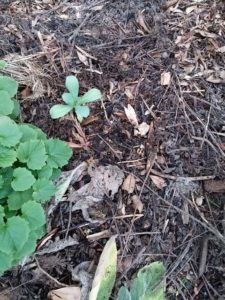 Depending on your point of view, you may think that having parts of your garden look like the picture on the right is too messy. You will need to decide how neat you want the garden to look or if productivity and resource conservation are more important.
Depending on your point of view, you may think that having parts of your garden look like the picture on the right is too messy. You will need to decide how neat you want the garden to look or if productivity and resource conservation are more important.
Depletes soil of nitrogen
If you chop’n’drop nitrogen-poor material there may be some depletion – but mainly right at the interface between plant material and soil surface. It shouldn’t be an issue if leguminous material is used.
Snail shelter
Those annoying creatures may love the layers of moist green matter. But there are usually other attractive places in the garden where they hide.
Disease spread
Dropping diseased plant material on the soil is not a good idea – just like it’s not a good idea to put it in your compost heap.
Can spread plants you don’t want everywhere
Plants which grow readily from seed could colonise your whole garden if they are chopped after they have gone to seed. But slashing them just as they flower will avoid this. In fact, it is a good way of getting rid of weeds which propagate by seed and making use of them at the same time.
Blows away or is a fire hazard in dry weather
In hot, dry weather this may be an issue unless the plant material is well watered or is chopped just before rain.
Can’t deal with household waste –e.g. food scraps
You will still need to employ a vermin-proof composting method or worm farm to recycle food waste.
Slower than proper composting with correct carbon:nitrogen ratios
If insufficient moisture is available this can be an issue. However, many sub-optimal home compost heaps with the wrong C:N ratios take a long while to decompose too because they never heat up sufficiently. Moreover, nutrients leaching from compost heaps only benefit the soil under them.
So will you chop’n’drop or not?
References
- Derpsch R. 2004. History of Crop Production,With & Without Tillage. Leading Edge 150.
- Shengzuo Fang, Baodong Xie, Huanchao Zhang. 2007. Nitrogen dynamics and mineralization in degraded agricultural soil mulched with fresh grass. Plant and Soil 300, 269.
- Nichols T. 2010. Don't Burn It - Hoogle It! Warm Earth 92, 22.
- www.permaculture.co.uk/articles/many-benefits-hugelkultur
- A.M O'Connell AM, Grove TS, Mendham DS, Rance SJ. 2004. Impact of harvest residue management on soil nitrogen dynamics in Eucalyptus globulus plantations in south western Australia. Soil Biology and Biochemistry 36, 39.
Pesticides in Fruit and Vegetables
We are all aware that fruit and veggies produced commercially, unless they are certified organic, have been exposed to pesticides at some stage in their growth and that they may still contain residues when we buy them. But do you know that there are some which are more contaminated than others? If ever you needed an incentive to grow your own, recent analyses of pesticide content provide just that. The resulting listings of the Dirty Dozen and the Clean Fifteen indicate which ones you will be best advised to grow yourself.
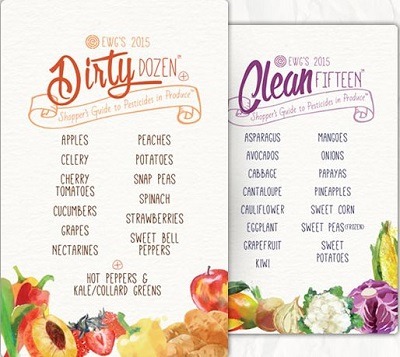 The Environmental Working Group (EWG) in the USA has just released its 2015 Shopper's Guide to Pesticides in Produce1. This large not-for-profit, independent group is comprised of many experts including scientists and other researchers. They analysed data from the US Department of Agriculture and the US Food and Drug Administration from 2013, covering 34,000 produce samples, and found that almost two-thirds contained pesticide residues.
The Environmental Working Group (EWG) in the USA has just released its 2015 Shopper's Guide to Pesticides in Produce1. This large not-for-profit, independent group is comprised of many experts including scientists and other researchers. They analysed data from the US Department of Agriculture and the US Food and Drug Administration from 2013, covering 34,000 produce samples, and found that almost two-thirds contained pesticide residues.
All produce was tested as it would be consumed i.e. washed and peeled if appropriate. The Dirty Dozen was calculated from combining rankings of each product according to 6 criteria:
- Percent of samples tested with detectable pesticides
- Percent of samples with two or more detectable pesticides
- Average number of pesticides found on a single sample
- Average amount of pesticides found, measured in parts per million
- Maximum number of pesticides found on a single sample
- Total number of pesticides found on the commodity"1
The report's key findings are:
- "99 percent of apple samples, 98 percent of peaches, and 97 percent of nectarines tested positive for at least one pesticide residue
- The average potato had more pesticides by weight than any other produce
- A single grape sample and a sweet bell pepper sample contained 15 pesticides
- Single samples of cherry tomatoes, nectarines, peaches, imported snap peas and strawberries showed 13 different pesticides apiece"1
Is this relevant to Australia?
You might say, "But Australian food has a reputation of being clean and green and U.S findings don't relate to us". But the few Australian studies that we could track down showed considerable overlap with the EWG findings. And commercial agriculture and pesticide use are similar in both countries.
In 2011, the Friends of the Earth (FoE) obtained a grant from the City of Yarra to produce a food guide and analysed Australian data from 2000 – 2011. Because monitoring of food is not performed consistently by a Federal government body, FoE analysed reports from the Australian Quarantine and Inspection Service (AQIS) Failing Food Reports, Food Standards Australia New Zealand (FSANZ) National Residue Surveys 2008-2010, FSANZ Total Diet Surveys 2003 and 2011, Victoria’s Department of Primary Industries (DPI) Produce Monitoring Reports 2007/8 –2008/9 - 2009/2010, Food Watch WA and other state based monitoring programs.2
| U.S. Produce1 | Australian Produce2 | ||
| 2010 | 2011 | 2013 | 2000 - 2011 |
| Celery | Apples | Apples | Apples |
| Peaches | Celery | Peaches | Pears |
| Strawberries | Strawberries | Nectarines | Strawberries |
| Apples | Peaches | Strawberries | Grapes |
| Blueberries | Spinach | Grapes | Lettuce |
| Nectarines | Nectarines (imported) | Celery | Nectarines |
| Sweet bell peppers | Grapes (imported) | Spinach | Peaches |
| Spinach | Sweet bell peppers | Sweet bell peppers | Tomatoes |
| Kale/Collard greens | Potatoes | Cucumbers | Apricots |
| Cherries | Blueberries | Cherry tomatoes | Carrots |
| Potatoes | Lettuce | Snap peas (imported) | Plums |
| Grapes (imported) | Kale/collard greens | Potatoes | Green beans |
#Listings are from highest to lowest levels of pesticides
Which pesticides?
The most frequent types of pesticides in food in Australia, according to the FoE study, are shown in the table below.
| Type of Pesticide | Percent of samples containing them |
| Insecticide | 39.5 |
| Fungicide | 32.1 |
| Synergist# | 5.6 |
| Herbicide | 4.1 |
| Other | 8.6 |
#Synergists block the ability of the target organism to break down the pesticide
These include a range of highly toxic chemicals such as chlorpyrifos, fenitrothion, difocol and dimethoate. Many are prohibited for use in the European Union and the U.S. Many persist in soil or find their way into waterways where they harm aquatic life.
An example is chlorpyrifos which is used commercially on a wide variety of crops, including fruits and vegetables. The safety advice prepared by manufacturers of commercial insecticides containing chlorpyrifos warns that it should not be used by householders in or around homes since it is too hazardous. Children and animals are more susceptible. It affects the nervous system and has been linked to interference with development of intelligence and to behaviour problems in children. It is toxic to bees, aquatic organisms including fish, and to some invertebrates and is currently under review by the National Registration Authority for Agricultural and Veterinary Chemicals. However, this chemical is present in some current garden products to kill lawn beetles and grubs.
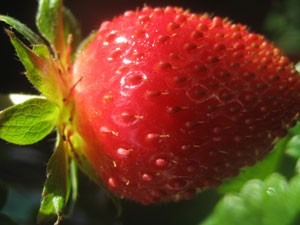 In 2008, Choice conducted a study on strawberries from 27 growers in all states (except Tasmania and South Australia) and found residues from 9 different pesticides with 17 samples containing 4 different chemicals3. Among the residues found were chlorpyrifos and dimethoate mentioned above.
In 2008, Choice conducted a study on strawberries from 27 growers in all states (except Tasmania and South Australia) and found residues from 9 different pesticides with 17 samples containing 4 different chemicals3. Among the residues found were chlorpyrifos and dimethoate mentioned above.
Regulation of allowable pesticide residues
In Australia, Food Standards Australia & New Zealand (FSANZ) and the Australian Pesticides and Veterinary Medicines Authority (APVMA) set Maximum Residue Limits (MRLs) for pesticide levels in fruit and vegetables. These limits are based on residue levels that might be expected if the use of the pesticide has been in accord with manufacturer's instructions and with required withholding periods which are set so that produce is safe for consumption4. MRLs also take into account the amounts of each food likely to be consumed.
Monitoring of residue levels in food is conducted in an Australian total Diet Survey by FSANZ every 3 years and by the Department of Agriculture in its National Residue Survey. States and territories also conduct surveys such as Food Watch in Western Australia and the Sydney Markets Residue Survey. The latter tested 6,900 samples of fruit and vegetables from 1989 to 2005 and found that most (97.5%) complied with the MRLs. Only 171 samples exceeded acceptable levels5. However, testing does not sample every grower or processor or every food. Imported fruit and vegetables make up over 10% of the total available, but only about 5% are tested by the Australian Quarantine and Information Service (AQIS). Not all pesticides are tested for and not all survey results are publicly available.
Should I eat only home-grown or organic?
The degree of risk associated with consuming non-organic fruit and vegetables is difficult to determine for any given individual. It depends on the amounts and combinations of pesticide residues consumed, at what stage of life, whether any effects accumulate over a lifetime and whether monitoring actually includes samples that would not meet MRLs.
The EWG's Clean Fifteen have the lowest levels of pesticides. Starting from lowest levels they are avocadoes, sweet corn, pineapple, cabbage, frozen peas, onion, asparagus, mango, papaya, kiwi fruit, eggplant, grapefruit, cantaloupe, cauliflower, sweet potato.
If you want to reduce levels of pesticides in your body when buying commercially grown produce, choose from the Clean Fifteen, buy less of the Dirty Dozen and seek out certified organic produce. Better still, grow you own with a focus on the Dirty Dozen - and avoid pesticide use in your garden.
For the full listing of produce examined by the EWG and FoE and more details on pesticides see the references below.
References
1. Environmental Working Group (2015) EWG's 2015 Shopper's Guide to Pesticides in Produce.
2. Friends of the Earth (2012) The dose makes the poison. www.foe.org.au/sites/default/files/TheDoseMakesThePoisonFeb2012_0.pdf
3. Choice (2014) Strawberries and pesticides. How do you pick the best and avoid an extra serving of chemicals?
4. Food Standards Australia & New Zealand (2013)
5. NSW Department of Primary Industries (2006) Spray sense. Information on Pesticide Issues, No. 3.
Pepino – a Perennial Fruiting Shrub
Who doesn’t like easy fruit growing? Especially in these days of changing climates, we look for edible plants that can withstand extremes. So the pepino (Solanum muricatum), known also as melon pear, is just the thing. It has been widely known in South America where it originated, but it took quite a while to get into Australian gardens. One of its big advantages is that it is a bushy shrub which persists from year to year in temperate regions and produces fruit for many months – even the whole year in warmer areas.
Strictly speaking, we should refer to it as Pepino dulce (sweet pepino) to distinguish it from the Spanish for cucumber which is just pepino. As you can tell from the botanical name, it is a member of the family Solanaceae and is, therefore, related to potatoes, tomatoes and eggplants.
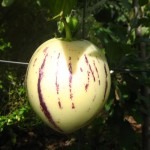

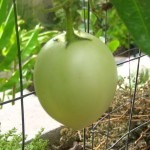 The bush produces clusters of purple and white flowers, which look like those of the potato, at the end of stems. Although self-fertile, fruiting will be enhanced by the presence of bees. Pepinos produce very pale green fruit which, as they grow larger and mature, develop purple stripes. At maturity the purple stripes are still there but the yellow becomes much darker.
The bush produces clusters of purple and white flowers, which look like those of the potato, at the end of stems. Although self-fertile, fruiting will be enhanced by the presence of bees. Pepinos produce very pale green fruit which, as they grow larger and mature, develop purple stripes. At maturity the purple stripes are still there but the yellow becomes much darker.
Growing pepinos
Like most fruit and veggies, it does best in a well-drained soil with a pH of 6.5 – 7.5. It helps to supply plenty of compost or worm castings, but steer clear of manures or other fertilisers which have higher nitrogen content in relation or potassium or phosphorus if you want to encourage fruiting rather than leaf growth. Since the roots are quite shallow, they have moderate water requirements, so keep the ground well mulched in summer. It will grow in a variety of climates, but although it prefers warmth, it will withstand short periods around 0°C if cut right back after fruiting and covered during frosts. Although they are susceptible to pests which attack tomatoes, in my hands at least, they don’t seem to suffer much from pest problems.
A trellis of some kind is usually necessary to stabilise the bush against strong winds and support the branches which grow quite heavy with fruit and, if left to trail on the ground, make an accessible and attractive meal for any wandering rodents. Just tie the branches to the support as they grow. One bush will spread to about 1 metre high and wide. As it grows, it is best to remove some of the shoots, especially those that point away from the trellis, so that plenty of air and light reach all parts of the bush. If you want to propagate pepinos, cuttings strike easily and branches will produce roots if they are touching ground. They can be grown from seed, but resulting plants may not be the same as the parent. At least 8 varieties which differ in their size, taste and texture are available in California, but not so many seem to be available in Australia.
Propagation
It grows readily from seed but is more easily grown from cuttings. Just take a woody section with a few leaves the top and place in soil or in a pot. It will also propagate by layering, so you can peg a branch down on the grounds and cover most of it with soil. After a month or so it will have formed roots and the branch can be cut from the parent bush and planted. This characteristic means that in some areas it is regarded as being weedy - so take care!
Using the fruit
Don’t be tempted to harvest fruit before they are really yellow since they won’t have acquired full sweetness. Ripe flesh is a very pale yellow-orange in colour. Pick the ripest fruit in the cluster, and the others will continue to mature. Handle carefully since they bruise easily. They can be stored on the kitchen bench for several days, or in the refrigerator for several weeks provided the temperature is not below 5° C.
Since they taste like rockmelon/honeydew melon with a hint of cucumber flavour they can be used in deserts or in savoury dishes. The skin is not normally eaten, although it can be. They make useful additions to fruit salads and can be turned into sweet sauces and chutneys. Try wrapping slices in prosciutto, mixing cubes with yoghurt or tossing in with lemon juice in savoury salads.
A versatile fruit!
References
Baxter P. and Tankard G. Growing fruit in Australia. 1990. MacMillan, Australia.
California Rare Fruit Growers. www.crfg.org/pubs/ff/pepino.html.
Locking up Carbon in Soil
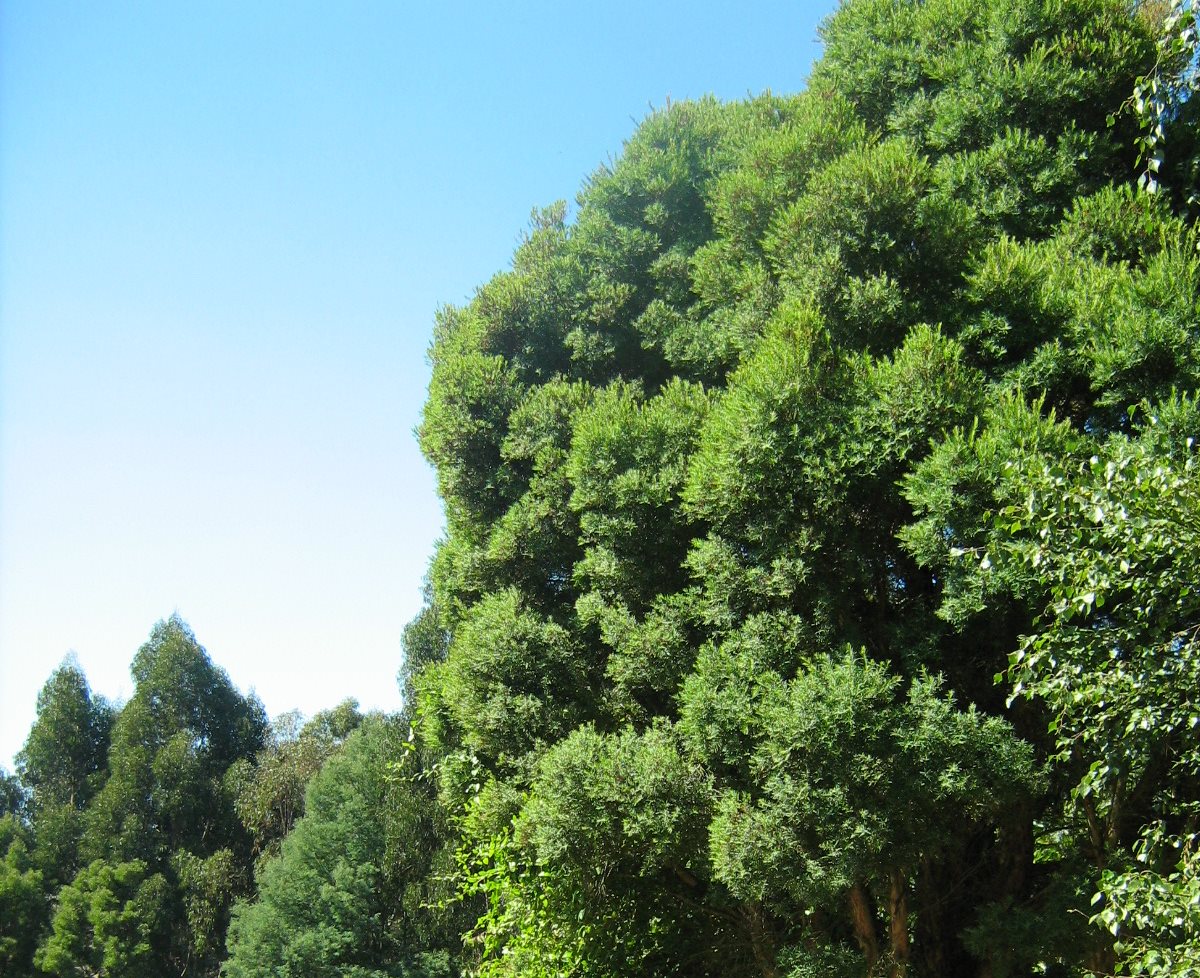 Messages about addressing climate change mostly focus on decreasing carbon dioxide emissions by reducing use of electricity and gas and increasing renewable energy. While these are extremely important, there also strategies for removing carbon from the atmosphere. We all know that planting trees and just growing more “green stuff” is a popular way of fixing carbon dioxide, but getting carbon into the soil itself is another approach that is now thought to lock it up for longer than can be achieved by tree planting. So who wouldn’t want to do that? Many “old” garden practices actually cause more carbon dioxide to be released, so what can gardeners do to reverse this? The good news is that more carbon in the soil also means more fertility.
Messages about addressing climate change mostly focus on decreasing carbon dioxide emissions by reducing use of electricity and gas and increasing renewable energy. While these are extremely important, there also strategies for removing carbon from the atmosphere. We all know that planting trees and just growing more “green stuff” is a popular way of fixing carbon dioxide, but getting carbon into the soil itself is another approach that is now thought to lock it up for longer than can be achieved by tree planting. So who wouldn’t want to do that? Many “old” garden practices actually cause more carbon dioxide to be released, so what can gardeners do to reverse this? The good news is that more carbon in the soil also means more fertility.
Neem
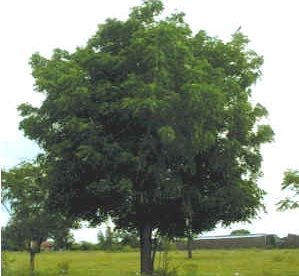 Neem products are sold for a variety of uses. In the garden, some people hail neem oil spray as a wonder pesticide. It has also found its way into toothpastes, medicines and herbal health preparations.
Neem products are sold for a variety of uses. In the garden, some people hail neem oil spray as a wonder pesticide. It has also found its way into toothpastes, medicines and herbal health preparations.
The Neem tree
Neem oil is the most commonly used product of the Neem tree (Azadirachta indica). The tree is a native of the Indian sub-continent where, for over 4000 years, it has been referred to as the “village pharmacy” and is regarded as sacred because of its wide variety of uses, particularly in Ayurvedic medicine. Its use is based on its insecticidal and antiseptic properties.
The tree has been introduced into other areas in the tropics including northern Australia. It is fast-growing, commonly reaching a height of 20 metres and, as a single specimen, to even around 35 metres. It has a dense, spreading crown to around 15 – 20 metres and is drought-tolerant – characteristics that lead to its use historically as a shade tree along streets, in schools and temple gardens. Its fragrant, white flowers form olive-like fruit about 2cm long which contain 1 – 3 seeds.
Because of its hardy nature, the neem tree has become a weed in many areas. Originally grown in Australia for commercial purposes, it has escaped from cultivation and grows wild, particularly in sandy river beds in the dry north. Although not declared as a weed by Queensland government1, it is in the Northern Territory and in both Queensland and Western Australia certain local governments name it on their weed list.
Neem as an insecticide
The neem tree contains at least 35 ingredients with insecticidal properties. The most active is azadarachtin which is commercially available In the USA as Margosan-O containing 0.3% azadarachtin. Neem preparations are also sold by several companies in Australia for agricultural and garden use.
Azadarachtin is found in all parts of the plant, with seeds being the richest source in the form of neem oil. A number of methods used to extract this oil and have been summarized by Infonet-Biovision, a project of the independent Biovision Foundation, Switzerland2 which provides a link between research institutions and local users, particularly in developing countries.
Neem oil can be extracted by drying neem tree leaves, crushing and grinding them before mixing the resulting powder water. A higher yielding process is crushing the seeds, mixing them with water and cold-pressing the resulting thick mixture to yield an oil rich in the active substance. The “cake” left after pressing oil also contains some active ingredient and when added to soil it helps control pests such as nematodes and parasitic fungi.
Because of the number of different substances in neem oil it works by a range of different means including affecting insect growth, inhibiting feeding, sterilization and inhibition of mating behavior or egg laying and blocking development of disease-causing 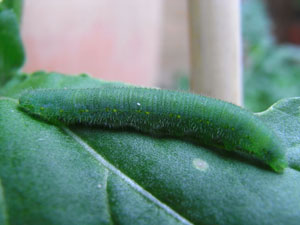 organisms carried by mosquitoes3. When neem is sprayed on plants it is effective against a wide range of leaf-eating or sap-sucking insects, but their susceptibilities vary. Those most susceptible include cutworm and larvae of moths, butterflies and beetles. Leaf miners, grass hoppers, locusts, aphids, some adult beetles, whiteflies, spider mites, fruit maggots, scale insects and fruit flies are also susceptible. The effect may take a few days to develop depending on how much they eat, how sensitive they are and how long the insectidical compounds persist in the plant. Several applications of neem oil may be needed, depending on the target insect, the plant they are eating and the time of year. Effects will also vary according to whether crude neem oil of purified azadarachtin is used.
organisms carried by mosquitoes3. When neem is sprayed on plants it is effective against a wide range of leaf-eating or sap-sucking insects, but their susceptibilities vary. Those most susceptible include cutworm and larvae of moths, butterflies and beetles. Leaf miners, grass hoppers, locusts, aphids, some adult beetles, whiteflies, spider mites, fruit maggots, scale insects and fruit flies are also susceptible. The effect may take a few days to develop depending on how much they eat, how sensitive they are and how long the insectidical compounds persist in the plant. Several applications of neem oil may be needed, depending on the target insect, the plant they are eating and the time of year. Effects will also vary according to whether crude neem oil of purified azadarachtin is used.
Beneficial insects which feed on caterpillars and larvae are not usually affected because they do not get enough of the neem extract to suffer harm by eating affected organisms. If you feel you need to use a spray, this makes it a better choice than most other insecticides containing artificial chemicals which also harm beneficial insects. Used as a plant spray, Neem appears to be non-toxic to humans, earthworms, animals, birds and bees. However, its bitter taste means that it is not suitable to spraying on leaves or fruit which you plan to eat.
What else is neem used for?
The range of uses for neem in traditional Indian medicine is startling. They include:
- As an antiseptic for cuts, sores and skin infections
- Herbal tea or capsules for kidney problems, sore throat, colds, fever, food poisoning, hypertension, respiratory problems, diabetes, hepatitis and kidney ailments
- Controlling head lice and scalp irritation in shampoos for humans and animals
In Australia neem is available as a plant spray, powder and pellets, in shampoo or soap for humans and pets and in various skin-care creams. It is also available as capsules and tea. Since there are conflicting reports about the safety of consuming neem, more research is needed and attention should be paid to risks of consuming it, especially for pregnant women.
References
1. www.business.qld.gov.au/industries/farms-fishing-forestry/agriculture/land-management/health-pests-weeds-diseases/weeds-diseases/invasive-plants/other/neem-tree
2. www.infonet-biovision.org/res/res/files/494.hdra%20NeemTree.pdf
3. Mulla MS, Su T (1999) Journal of the American Mosquito Control Association 15(2):133-152.
Picture: www.organeem.com/neem_tree.html
Your Garden and your Ecological Footprint
Can what we do in our gardens affect our ecological footprint? You bet it does, and we explore here just how.
Do you know what Australia’s ecological footprint is? It’s certainly bigger than that of India, Egypt, Finland or even the United Kingdom, but not greater than that of Canada or the USA. I’m sure you don’t need a reminder, but just in case, the ecological footprint is a measure of the area of land and water it takes to provide a person or population with the resources it uses. It includes productive land and water, that used for roads, cities and other infrastructure and the ecosytems that are required to deal with waste. So it is a measure of human demand on nature’s capacity – a measure of how the natural environment is affected by human impact.
The worldwide footprint is 1.7 of the earth, based on the most recent calculations by the Global Footprint Network, in 2010. That means that the world is consuming 1.7 times the earth’s capacity. Australia’s was 6.8 with the biggest component coming from grazing. So if the whole world was having the treating the environment in the same way as Australia, we’d need 6.8 earths to support us!
Developed nations use more resources than those that are developing. Some examples are Afghanistan with a footprint of 0.6, Cambodia with 1.0, Pakistan with 0.8. However, most of the others are now over 1.0.
So what can we do about what looks like certain complete depletion of the earth’s resources? A start is to look at our own lifestyles. We might think that an individual contribution is unimportant when the rest of the world needs to do something too. But remember, every great change in history has always started with one person whose behaviour influences others.
How can we use our gardens to reduce our individual footprint?
If you follow the strategies that Sustainable Gardening Australia recommends in its gardening booklets and training workshops, you are well on the way to reducing your footprint. You really need to think about the energy and material resources that go into all aspects of your garden – and dwelling.
Grow shade and insulation
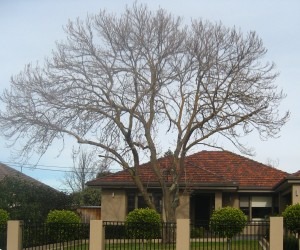
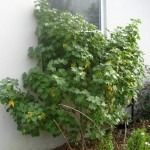 Shade from trees can reduce the air temperature by as much as 5 degrees C. A garden landscaped for shade can reduce home energy costs by 15 – 50%1. Plant deciduous trees on the north side of the house to let in winter sun and provide shade in summer.
Shade from trees can reduce the air temperature by as much as 5 degrees C. A garden landscaped for shade can reduce home energy costs by 15 – 50%1. Plant deciduous trees on the north side of the house to let in winter sun and provide shade in summer.
Energy use and greenhouse gas emissions will be reduced in both seasons. Low canopies on the west will shade out late afternoon summer sun. Shrubs and ground covers cool the air around the house as air 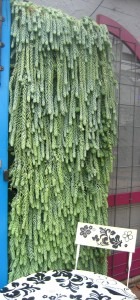 flows over and through them. Shrubs and trellised vines close to walls will provide insulation in all seasons - just watch out that shrubs and trees do not have invasive root systems that might affect the house foundations.
flows over and through them. Shrubs and trellised vines close to walls will provide insulation in all seasons - just watch out that shrubs and trees do not have invasive root systems that might affect the house foundations.
Rooftop and vertical gardens fulfil similar functions.
Grow wind protection
Wind will disturb the air envelope around your house, whipping away warmth seeping from it in winter. Plant tall evergreens 2 – 5 times the height of the house at maturity so that they block prevailing winds – their location on your land will depend on where you live
Reduce use of chemicals that involve manufacturing
Such products are often derived from oil and use quite a bit of energy in their manufacture. And they eventually are washed in stormwater to pollute waterways. Synthetic liquid fertilisers can contribute to the conditions that produce algal blooms. So think carefully before you reach for the bug spray or synthetic fertiliser! There are many good, sustainable alternatives. Remember if you have created a microbially rich soil with compost and manures your plants will be healthy and more disease-resistant. Companion planting can help attract beneficial insects to prey on the nuisance ones. Make your own fertilizer and pest remedies.
Grow your own food
Not only does this help to reduce the distance your food travels before it hits your plate, but it also helps to save water and fossil fuels and use of pesticides, herbicides. If you do buy, try to ensure that it has minimal packaging, is in season, organic, mostly vegetable and not processed2. If you buy fish, consult the Marine Conservation Society’s excellent booklet on sustainable fish. According to the EPA, buying organic food reduces your food footprint by 15%3.
Reduce, reuse, recycle
Compost your waste. Use this valuable resource rather than letting it go to landfill. Reuse timber, pots and whatever else you can. Sometimes the old and slightly worm materials look more interesting and do the same job as new ones.
When buying pavers, mulch etc check where it comes from. Can you save transport emissions by buying local?
Create habitat
A diverse range of indigenous plants will help provide a habitat for animals, beneficial insects and birds.
Watch out for environmental weeds
Your local council will have a list of environmental weeds (often garden escapees). Prevent their spread into neighbour's gardens or to conservation reserves by eradicating them safely or containing them. Do NOT let them go to seed or spread by underground runners.
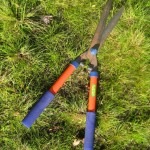 Use person power rather than electric, oil or batteries in tools
Use person power rather than electric, oil or batteries in tools
Why use an electric hedge trimmer when a good pair of shears will do the same thing - and provide some exercise for you into the bargain. The same thing goes for lawn mowers – hand push mowers work really well and give you a good workout – or have a lawn of indigenous grasses or alternative groundcovers which do not require mowing. Some of these alternatives are shown on the right in a garden centre display.
Conserve water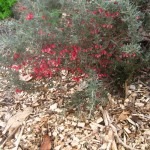
Group plants with similar water needs. It’s best to water in the morning so that less is lost to evaporation, but the roots can make maximum use of it. Indigenous plants require less water. Use mulch (preferably made from chopping up your own prunings) to prevent further water loss.
If you do all these things, you are making a contribution to reducing your ecological footprint!
References
1. http://energy.gov/energysaver/articles/landscaping-shade
2. http://www.foodchoices.com.au/samples/resource%20sheet%2056.pdf
3. http://www.epa.vic.gov.au/~/media/Publications/1219.pdf
SharronP is a passionate gardener and environmentalist who has been a senior lecturer and researcher at Monash University in environment, sustainability and health. She works with several environmental and gardening groups and encourages people to work cooperatively to protect and enhance the natural environment.


